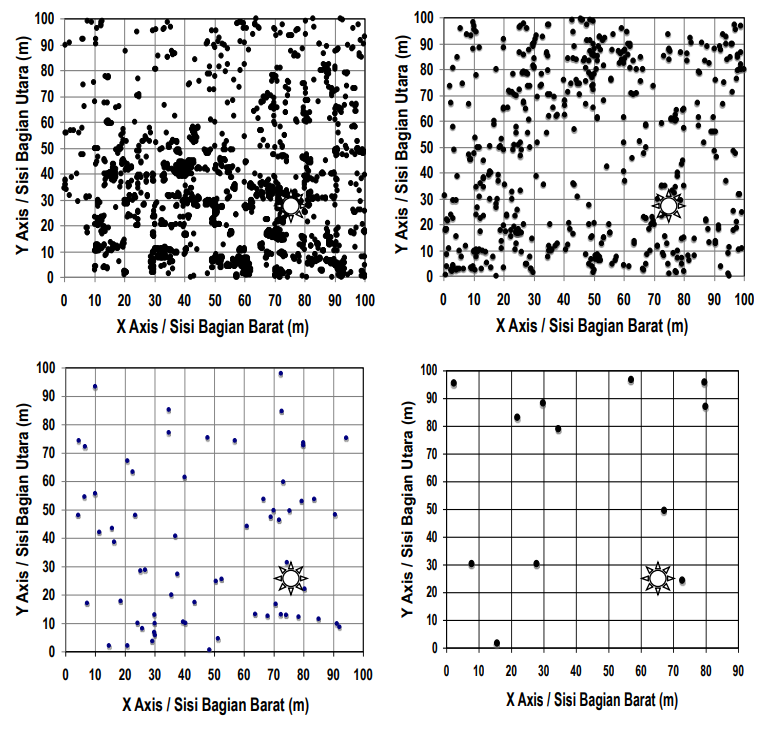Distribution and population structure of the juvenile of Diospyros celebica bakh. Under the canopy of their mother-tree

Downloads
Downloads
Achmad, A. (2002). Strategi konservasi in-situ eboni bergaris/kayu hitam Makassar (Diospyros celebica Bakh.) di Sulawesi. (Dalam: Manajemen eboni (Diopyros celebica Bakh.) dalam mendukung keunggulan industri menuju otonomisasi dan era pasar bebas). Edisi Khusus Berita Biologi, Vol. 6 (2), 339-351.
Achmad, A., P.O. Ngakan, R.I. Maulany, dan Asianny. (2014). Populasi, pergerakan harian, dan habitat kuskus beruang (Ailurops ursinus) di Hutan Pendidikan Unhas. Fakultas Kehutanan. Laporan Penelitian Kompetensi Laboratotium Universitas Hasanuddin.
Achmad, N. S. (2011). Jenis, kelimpahan, dan distribusi tumbuhan pakan Macaca Maura Schinz di Hutan Pendidikan Universitas Hasanuddin Sulawesi Selatan. (Skripsi) Makassar: Fakultas Kehutanan Universitas Hasanuddin.
Brower, J. E., J. H. Zar and C. N. Von Ende. (1990). Field and laboratory, methods for general ecology (3th. ed.). Win. C. Brown Publishers. Doduque, Iowa.
Daniel. (2012). Penyelundupan Eboni Ke Malaysia Masih Marak. Antara, Jumat 3 Februari 2012. http://www.antarasulsel.com.
Engelbrecht, B.M.J., T.A. Kursar and M.T. Tyree. (2005). Drought effects on seedling survival in a tropical moist forest. Trees, 19, 312–321.
Hendromono. (1995). Pertumbuhan dan mutu bibit eboni (Diopyros celebica Bakh.) pada tiga jenis medium yang dipupuk NPK. Jurnal Litbang Kehutanan, 7(1), 28-31.
Hendromono. (2007). Teknik pembibitan eboni dari anakan hasil permudaan alam. Jurnal Penelitian Hutan Tanaman, 4(2), 069 – 118.
Informasi Tanaman Kehutanan. (2011). Diospyros celebica Bakh./Eboni. Informasi Tanaman Kehutanan, http://forestryinformation.wordpress.com/2 011/07/16/ diospyros-celebica-bakh-eboni/, diakses 18 April 2013.
Kitajima, K. and C. K. Augspurger. (1989). Seed and seedling ecology of a monocarpic tropical tree Tachigalia vercicolor. Ecology, 70(4), 1102 – 1114.
Kurniawan, E. (2013) Strategi penyelamatan eboni (Diospyros celebica Bakh.) dari ancaman kepunahan. Info Teknis Eboni, 10(2), 99 – 106.
Mao, P., G. Han, G. Wang, J. Yu, and H. Shao. (2014). Effects of Age and Stand Density of Mother Trees on Early Pinus thunbergii Seedling Establishment in the Coastal Zone, China. The Scientific World Journal, 2014, 1-9.
Maringer J. ,T. Wohlgemuth, C. Neff, G. B. Pezzatti, M. Conedera. (2012). Post-fires preadofalien plant species ina mixed broad-leaved forest of the Insubric region. Flora, 207, 19 – 29.
Nasri. (2015). Studi ekologi reproduksi, regenerasi dan koeksistensi eboni (Diospyros celebica Bakh.) di Hutan Pendidikan Universitas Hasanuddin. (Tesis Progam Magister) Makassar: Fakultas Kehutanan Universitas Hasanuddin.
Ngakan, P.O. (2002). Pendekatan teknis pelestarian eboni (Diopyros celebica Bkh.) secara Ex-Situ. (Dalam: Manajemen eboni (Diopyros celebica Bakh.) dalam mendukung keunggulan industri menuju otonomisasi dan era pasar bebas). Edisi Khusus. Berita Biologi, 6(2), 267-275.
Nurkin, B. (2011). Keterlibatan masyarakat dalam upaya konservasi eboni di Maros, Sulawesi Selatan. Proceeding Lokakarya Nasional: Status Konservasi dan Formulasi Strategi Konservasi Jenis-Jenis Pohon yang Terancan Punah (Ulin, Eboni dan Michelia), 204-214.
Okusanya, O.T., O.O. Shonubi and S.E. Babalola. (2015). Natural seed germination and seedling dynamics in cultivated population of Cassia fistula Linn. in Nigeria. African Journal of Agricultural Research, 10(8), 865-870.
Prasetyawati, C. A. dan E. Kurniawan. (2013). Eksplorasi Anakan Alam Eboni (Diospyros celebica Bakh.) di tiga kabupaten di Sulawesi Selatan. Info Teknis Eboni, 10(2), 117 – 126.
Prastyono dan B. Ismail. (2014). Eksplorasi dan koleksi materi genetik eboni (Diospyros celebica Bakh.) untuk pembangunan plot konservsi sumberdaya genetik. Wana Benih, 15(1), 41-60.
Rachman, T. (2015). Eboni Mamuju Diselundupkan Hingga Eropa. http://www.republika.co.id/berita/regional/ nusantara/11/05/10/lkybu5. Diakses 2 Maret 2015
Republika Online. (2011). Eboni Mamuju diselundupkan sampai Eropa. Republika Online. http://www.republika.co.id/berita/regional/ nusantara/11/05/10/lkybu5 diakses 17 April 2013.
Restu, M. (2006). Potensi dan permudaan tegakan alam eboni (Diospyros celebica Bakh.) di areal HPH PT. Inhutani Mamuju. Jurnal Perrenial, 2(2), 44-46.
Restu, M. dan Mukrimin. (2007). Keragaman genetik eboni (Diospyros celebica Bakh.) provenansi Amaro Kabupaten Barru. Jurnal Hutan dan Masyarakat, 2(3), 263-267.
Riswan, S. (2002). Kajian biologi eboni (Diospyros celebica Bakh.). (Dalam: Manajemen eboni (Diopyros celebica Bakh.) dalam mendukung keunggulan industri menuju otonomisasi dan era pasar bebas). Edisi Khusus. Berita Biologi, 6(2), 211-217.
Russo, S.E. and C.K. Augspurger. (2004). Aggregated seed dispersal by spider monkeys limits recruitment to clumped patterns in Virola calophylla. Ecology Letters, 7, 1058–1067.
Sagnotti, C. (2013). Diet prefernces and habitat use in relation to reprodutive states in females of a wild group of Macaca maura inhabiting Karaenta forest, South Sulawesi. (Master Thesis) Makassar: The Faculty of Forestry Hasanuddin University.
The Indonesian Wildlife Conservation Foundation. (2011). Eboni (Diospyros celebica Bakh.). The Indonesian Wildlife Conservation Foundation, http://www.iwf.or.id/ detail_flora/42, diakses tanggal 18 April 2013.
Von Arnim, A. and X.W. Deng. (1996). Light control of Seedling Development. Annu. Rev. Plant Physiol. Plant Mol. Biol., 47, 215–43.
Wahyudi. (2002). Pola penyebaran ekologis jenis eboni Makassar (Diospyros celebica Bakh.) di hutan Amaro Kabupaten Barru. (Skripsi) Makassar: Jurusan Kehutanan Fakultas Pertanian dan Kehutanan Universitas Hasanuddin.
Walters, C.T., P. Berjak, N. Pammenter, K. Kennedy dan P. Raven. (2013). Preservation of Recalcitrant Seeds. Science, 339, 915-916.
Widyatmoko, A YPBC, ILG Nurtjahjaningsih and Prastyono. (2011). Study on the level of genetic diversity of Diospyros celebica, Eusideroxylon zwageri and Michelia spp. using RAPD markers. Technical Report 2. Centre for Conservation and Rehabilitation Research and Development.
Yuniarti, N., D. Syamsuwida, A. Aminah. (2013). Dampak perubahan fisiologi dan biokimia benih eboni (Diospyros celebica Bakh.) selama penyimpanan. Jurnal Penelitian Hutan Tanaman, 10(2), 65-71.








